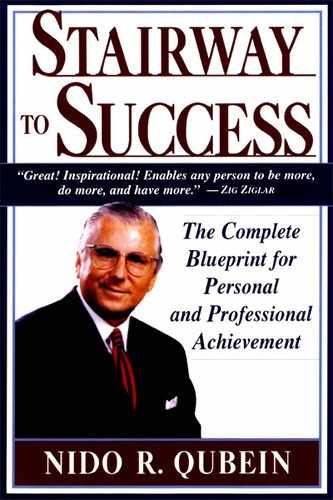Introduction
They can because they think they can.
—VIRGIL
Wherever my career takes me—from my home town of High Point, North Carolina, to the ministate of Luxembourg; from the island city-state of Singapore to the island continent of Australia—I encounter people pursuing a common quest: success.
Many come to me in search of a secret formula. They’ve labored for years, butted their heads against walls, suffered failure and rejection, and they wonder: “Is it possible for me to achieve success, given my level of talent and education?” And I have a ready response: You can if you want to.
Success is not a matter of luck, an accident of birth, or a reward for virtue. It is a matter of decision, commitment, planning, preparation, execution, and recommitment. Success doesn’t come to you; you must go to it. The trail is well-traveled and well-marked. If you want to walk it, you can. This book will help you find the right steps.
“But you’ve got to have talent to be successful,” people tell me—and they’re right. But everyone has talent. Michael Jordan’s talent is bouncing a basketball down the court and shooting it through a hoop. That’s how he made it to superstardom. When he tried swinging a baseball bat and catching a baseball with a leather glove, he had to begin in the minor leagues.
Henry Ford’s talent was building automobiles. He wouldn’t have made it as the CEO of an insurance company, and he was far from brilliant as the CEO of an automobile company. But when it came to the manufacturing process, his talent shone.
Richard Burton’s talent was acting. He was an indifferent singer. When he starred in the musical Camelot, Burton was carried by the singing talent of Julie Andrews and Robert Goulet. But Burton excelled at acting the role of King Arthur.
Some people are talented at driving nails, some at shaping clay, some at speaking before audiences, some at writing novels, some at skating, some at dancing, some at sewing, some at cooking.
But everyone is talented. We’re just talented in different ways. If you want to succeed, identify the areas in which you are talented and commit to developing those talents to the fullest.
You can do it if you want to. The secret is in the six steps I’ll outline in this book:
Step 1. Decision. Decide what you want in life. Make it a decision that comes from deep inside you. This means getting to know yourself. Identify the things you do well and the things you enjoy doing. Get familiar with the way you respond to your environment and why you respond that way. Learn where you’re strong and play to your strengths. When you’ve defined yourself, you can also define the success you want-and can begin the journey toward your dreams.
Step 2. Commitment. It’s one thing to decide what you want. It’s another thing to make a commitment. A commitment is like your signature on a contract: It binds you to a course of action. When you make a deep commitment to a goal, powerful forces come into play, propelling you toward that goal. The power comes from within you. It’s there, and you may not even know it.
Step 3. Planning. Here is where one three-letter word separates losers from winners. That word is how. Losers ask “Can I do it?” Winners ask “How can I do it?” Losers are guided by what’s impossible. They see barriers and they stop in their tracks. Winners are guided by what’s possible. They see possibilities and then build upon them. By devising a strategy one possibility at a time, they achieve their goals.
Step 4. Preparation. Once you know where you want to go, your next step is to prepare yourself for the journey. Preparation involves acquiring the physical, mental/emotional, social, and spiritual balance you’ll need to keep yourself on course, and the motivation to provide you with the energy to carry it out.
Step 5. Execution. Executing your life’s plan involves three phases: action, learning, and applying. A good coach knows that a brilliant game plan is no good without proper execution. The team has to act upon the plan. It’s the same with your success plan. It’s not enough to have one. You have to implement it through positive action. Coupled with the action must be a learning process that allows you to profit from your inevitable mistakes. We never know whether a specific action will be successful until we’ve tried it. Once we’ve tried it, we can observe the results, learning what works and what doesn’t. Winners expect to make mistakes, but they use them as lessons. They apply what they learn toward implementation of the plan.
Step 6. Recommitment. When you’ve achieved the last goal in your action plan, don’t stop. Your life is not at an end. You’re at a new beginning-unless you plan to die as soon as your vision is fulfilled. Successful people know that life is a continuously unfolding process, and they remain in control of the unfolding. When they reach that long-sought plateau, they immediately create their next vision. They move on to new plateaus, making new decisions and new commitments, planning, preparing, and executing until the new vision is achieved. Success builds upon success.
If you follow these six steps, you’ll succeed-not because there’s magic in the formula but because there’s power in you, the power to accomplish whatever you want to accomplish. And with God’s help, you can do it.
